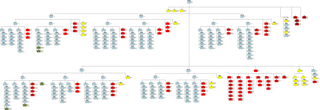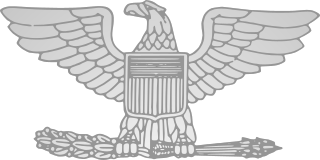The following Confederate States Army units and commanders fought in the Battle of Wilson's Creek of the American Civil War, fought on August 10, 1861 near Springfield, Missouri. Though identified with the Confederates, the Missouri State Guard were technically an independent army, as Missouri had not yet seceded, and were not folded into the Confederate Army of the West until March 17, 1862. Though identified with the Confederates, the Arkansas State Troops were technically not yet Confederate troops. Arkansas had seceded on XX and be recognized as a Confederate States, but Brigadier General Nichols Pearce's troops had not been transferred from the State of Arkansas to the Confederate Government and had not been sworn into Confederate Service. After the battle, Pearce's troops voted to disband rather than enter Confederate Service.

The following Confederate States Army units and commanders fought in the Battle of Shiloh of the American Civil War. The Union order of battle is shown separately. Order of battle compiled from the army organization during the battle.
The following Confederate States Army units and commanders fought in Maryland's Frederick County Battle of Monocacy on July 9, 1864, during the American Civil War. The Union order of battle is shown separately.
The following Union Army units and commanders fought in the Battle of Monocacy of the American Civil War. The Confederate order of battle is shown separately.
The following Confederate States Army units and commanders fought in the Siege of Vicksburg of the American Civil War. The Union order of battle is listed separately. Order of battle compiled from the army organization during the campaign.

The following Union Army units and commanders fought in the Seven Days Battles of the American Civil War. Order of battle compiled from the army organization-return of casualties during the battle and the reports. The Confederate order of battle is listed separately.
The following Confederate States Army units and commanders fought in the Battle of McDowell of the American Civil War. The Union order of battle is listed separately.
The following United States Army units and commanders fought in the Battle of McDowell of the American Civil War. The Confederate order of battle is listed separately.
The following United States Army units and commanders fought in the Battle of Cross Keys of the American Civil War. The Confederate order of battle is listed separately.
The following Confederate States Army units and commanders fought in the Battle of Cross Keys of the American Civil War. The Union order of battle is listed separately.
The following Confederate States Army units and commanders fought in the Battle of Port Republic of the American Civil War. The Union order of battle is listed separately.
The following Confederate States Army units and commanders fought in the siege of Petersburg of the American Civil War. The following order of battle is the organization from the Confederate forces near Petersburg of October 27, 1864.
The following United States Army units and commanders fought in the First Battle of Winchester of the American Civil War. The Confederate order of battle is listed separately.
The following Union Army units and commanders fought in the Battle of Opequon of the American Civil War. The Confederate order of battle is listed separately.
The following United States Army units and commanders fought in the Battle of Williamsburg of the American Civil War. The Confederate order of battle is shown separately.
The following Union Army units and commanders fought in the Second Battle of Petersburg of the American Civil War. Order of battle compiled from the casualty returns. The Confederate order of battle is listed separately.
The following Confederate Army units and commanders fought in the Second Battle of Corinth of the American Civil War on October 3 and 4, 1862, in Corinth, Mississippi. Order of battle compiled from the army organization during the battle and reports. The Union order of battle is listed separately.
The following Union Army units and commanders fought in the Siege of Charleston Harbor of the American Civil War. The Confederate order of battle is listed separately.
The following Union Army units and commanders fought in the Battle of Arkansas Post (1863) of the American Civil War. The Confederate order of battle is listed separately. Order of battle compiled from the army organization and return of casualties during the battle.
The following Union and Confederate army units and commanders fought in the Battle of Franklin on April 10, 1863. Organization is compiled from the Official Records of the American Civil War.
For the Battle of Franklin fought on November 30, 1864 see: Battle of Franklin (1864) Union order of battle and Battle of Franklin (1864) Confederate order of battle.





